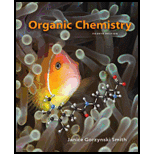
(a)
Interpretation: The product of given electrocyclic reaction is to be drawn.
Concept introduction: Electrocyclic reactions involve ring opening or ring closure in a conjugated polyene. According to Woodward-Hoffmann rules, the polyene containing even number of bonds in thermal conditions undergoes reaction in conrotatory fashion and polyene containing odd number of bonds undergo reaction in disrotatory fashion.
(b)
Interpretation: The product of given electrocyclic reaction is to be drawn.
Concept introduction: Electrocyclic reactions involve ring opening or ring closure in a conjugated polyene. According to Woodward-Hoffmann rules, the polyene containing even number of bonds in photochemical conditions undergoes reaction in disrotatory fashion and polyene containing odd number of bonds undergo reaction in conrotatory fashion.
(c)
Interpretation: The product of given electrocyclic reaction is to be drawn.
Concept introduction: Electrocyclic reactions involve ring opening or ring closure in a conjugated polyene. According to Woodward-Hoffmann rules, the polyene containing even number of bonds in thermal conditions undergoes reaction in conrotatory fashion and polyene containing odd number of bonds undergo reaction in disrotatory fashion.
(d)
Interpretation: The product of given electrocyclic reaction is to be drawn.
Concept introduction: Electrocyclic reactions involve ring opening or ring closure in a conjugated polyene. According to Woodward-Hoffmann rules, the polyene containing even number of bonds in photochemical conditions undergoes reaction in disrotatory fashion and polyene containing odd number of bonds undergo reaction in conrotatory fashion.
Want to see the full answer?
Check out a sample textbook solution
Chapter 27 Solutions
Organic Chemistry
- Show the product of the Diels–Alder reaction of the following diene with 3-buten-2-one, H2C = CHCOCH3. Make sure you show the full stereochemistry of the reaction product.arrow_forward(1) Which is an isolated diene? (2) Which is an alkene with possible rearrangement product (1,2-H shift) with reaction to HI? (3) Whixh isa diene capable of having 1,2 and 1,4-addition products? (4) Which is a conjugated diene?arrow_forwardBased on your knowledge in biological chemistry reaction in biomolecules, what do you think is the best type and product for the above reaction? a. SN1 b. SN2 c. E1 d. E2 e. None of the abovearrow_forward
- Please complete boxed reactions. Thanks. P.s. this is not graded work but a study guide.arrow_forwardWhen Br2 is added to buta-1,3-diene at -15 °C, the product mixture contains 60% ofproduct A and 40% of product B. When the same reaction takes place at 60 °C, theproduct ratio is 10% A and 90% B.Show why A predominates at -15 °C and B predominates at 60 °C.arrow_forwardType of leaving groups favorable for SN2 & SN1 reactions & 3 examples SN2 SN1arrow_forward
- Consider the E1 reaction of 3-bromo-2-cyclohexyl-butane. How many elimination products are possible? Include (E)/(Z) isomers as separate products.arrow_forward1. What is reaction 1? a Halogenation via SR b Halogenation via SE c Halogenation via AE d Hydrohalogenation via AE 2. Which pair of reagent/catalyst is needed for reaction 1? a HBr / DCM b Br2 / CCl4 c NBS / H2O2 d Br2 / uv 3. What is reaction 2? a FC Acylation b FC Alkylation c Halogenation via SE d Brominationarrow_forwardIn the reaction below, 3-Buten-2-one reacts with 2,3-Dimethyl-1,3-butadieneand 1,3-Butadieneat 140°C and 30°C, respectively. Explain why these two dienes react at different temperatures.arrow_forward
- 2) Draw and name the organic compound found in every reaction. d) Reaction of cis-3,3-Dimethyl-4-propylocta-1,5-diene with two mole of HBr e) Reaction of trans-1-Bromo-3-chlorocyclopentane with potassium hydroxide f) Formation of Gilman reagent using isopropyl bromide g) Ozonolysis of 3,3-Dimethyloct-4-yne h) Complete halogenation (Cl2) of 3-Ethyl-5-methyl-1,6,8-decatriyne i) Partial hydrogenation using Lindlar's Catalyst 2,2,5,5-Tetramethylhex-3-yne j) Reaction of 3,4-Dimethylcyclodecyne with sodium amidearrow_forwardWhich of the following reactions result in a positive ∆ Ssys? a. H2O(g) = H2O(l) b. H2(g) + I2(g) = 2 Hl(g) c. C2H2O2(g) = 2CO(g) + H2(g) d. H2O(g) + CO2 (g) = H2CO3(aq)arrow_forward6. Identify the best reagent(s) for this reaction. (see attached screenshot). a. H2SO4, HgSO4, H2O b. 1. Disiamylborane, 2. HO–, H2O2 c. K2Cr2O7, H+ d. NaOCl e. H2, Pdarrow_forward

 Organic Chemistry: A Guided InquiryChemistryISBN:9780618974122Author:Andrei StraumanisPublisher:Cengage Learning
Organic Chemistry: A Guided InquiryChemistryISBN:9780618974122Author:Andrei StraumanisPublisher:Cengage Learning Organic ChemistryChemistryISBN:9781305580350Author:William H. Brown, Brent L. Iverson, Eric Anslyn, Christopher S. FootePublisher:Cengage Learning
Organic ChemistryChemistryISBN:9781305580350Author:William H. Brown, Brent L. Iverson, Eric Anslyn, Christopher S. FootePublisher:Cengage Learning


